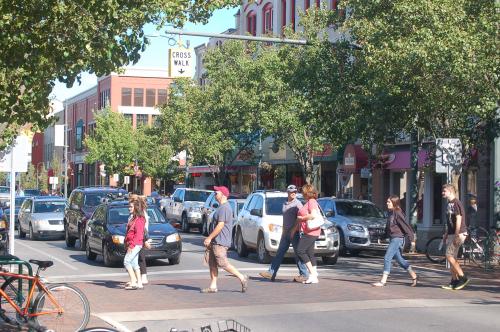Walkability, quality of life and healthy, vibrant Communities all come together in one package
Jeff Speck advocated creating walkable communities with his book Walkable City. Speck was a featured speaker at the Michigan Association of Planning conference in Kalamazoo, Mich.
“Planners screwed up for the past 20 to 40 years” Jeff Speck said at the Michigan Association of Planning (MAP) annual conference in what Speck called his “civilized rant to convince communities to do what they should be doing.”
Speck is the author of the book Walkable City, How Downtown Can Save America One Step at a Time. Speck has dedicated his career to determining what makes cities thrive. And he has boiled it down to one key factor: walkability. His talk at MAP reviewed the findings and content of his book.
He started his October 4, 2013 talk by pointing out how the book Bowling Alone took a sociological look at the results of development sprawl. In short, sprawl is automobile-dependent: the automobile is needed to get anywhere one goes. For each additional 10 minutes tacked onto an individual’s commute, that is 10 percent less time is spent being engaged in one’s community.
Speck used the recruiting problems of one Michigan corporation as an example. Employees of the company indicated they loved their job, but spouses could not socially connect in the company’s home town. In a sprawl development landscape it is far less likely that people bump into others or become involved in community.
The problems faced by that one corporation – which are similar problems for many companies – are further magnified by our young millennial generation also wanting change. Millennials are looking for communities that provide biking, public transit and an urban core or downtown environment.
“Sixty-six percent of millennials decide where to live, move, then get a job,” Speck said. The baby boomer generation now also wants to move to urban core. As people age it becomes more important to live where people can still get around and be self-sufficient, even without a car.
Speck called such communities NORC (Naturally Occurring Retirement Communities) as the new growth areas because people can be social, active and have mobility without a car. Such communities are the opposite of sprawl, with good urban design and new urbanism characteristics.
In 1970, the average household spent about 10 percent of its income on transportation, Speck said. In 2012 that average increased to 20 percent of income. The lower-income residents can spend as much as 40 percent of income on transportation. The result is most people spend more on transpiration than on housing.
From a health perspective one can conclude that sprawl is making people sick. Community design contributes to obesity, diabetes because of lack of exercise and diet. Speck points out that the book Urban Sprawl and Public Health cites studies that show inactivity is the problem, and when community design prevents or discourages walking, those communities are facing more public health problems.
Also, deaths from automobile use are higher in urban areas which have sprawl development patterns Speck said. The United States average is 12 deaths per 100,000 inhabitants per year. In the United Kingdom it is seven per year, and four per year in Japan. In United States cities which have been successful in avoiding or retrofitting sprawl development auto deaths are about three per year (Portland, Oregon and New York City).
“Compact urban areas are more energy efficient,” Speck said. Those in New York use one third the amount of fuel per person and one half the amount of electricity per person compared to the United States average.
Speck concluded his talk pointing out if a region wants to be competitive in the new global economy, the regional community needs to provide a high quality of life (healthy, energy efficient and desired living environment). And a high quality of life is the same, or similar to being sustainable: which is walkable communities that provide choices for different transportation options.
There are many other Michigan State University Extension articles on walkability, as well as training programs on Michigan’s complete streets.



 Print
Print Email
Email
